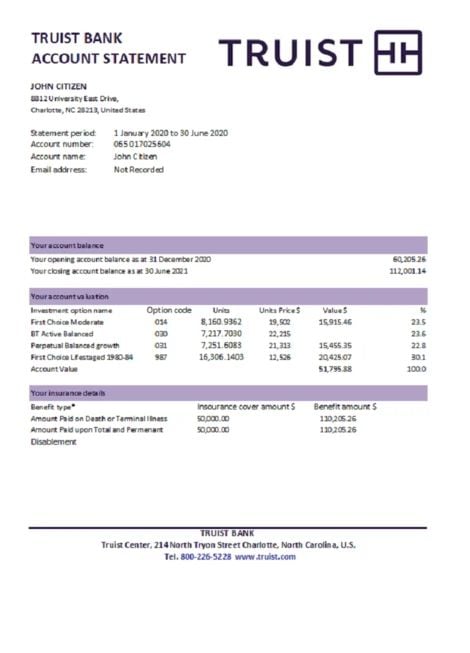Are you tired of sleepless nights worrying about your business’s financial future? 😓 The solution might be closer than you think – right in your business bank statements! 💼💰
Securing a business loan can be a game-changer, but the approval process often feels like navigating a maze blindfolded. One key to unlocking this puzzle lies in your business bank statements. These financial records are more than just numbers; they’re a powerful tool that can open doors to the funding your business needs to thrive.
In this post, we’ll demystify the process of using business bank statements for loan approval. We’ll guide you through the required documents, explore different types of business loans, and reveal the secrets of a successful application. From understanding collateral requirements to timing your application just right, we’ve got you covered. So, let’s dive in and discover how your bank statements can become your ticket to financial growth! 🚀💼
What are some of the required documents that I need?

Personal and Business Documents
When applying for a business loan, you’ll need to provide various personal and business documents. Here’s a list of commonly required items:
-
Personal tax returns (last 2-3 years)
-
Business tax returns (last 2-3 years)
-
Personal financial statement
-
Business financial statements (balance sheet, income statement, cash flow statement)
-
Business bank statements (last 3-6 months)
-
Business licenses and registrations
-
Business plan or loan proposal
Financial Records and Statements
Financial records play a crucial role in the loan approval process. Here’s a table summarizing the key financial documents and their importance:
| Document | Purpose |
|---|---|
| Bank Statements | Show cash flow and financial stability |
| Tax Returns | Verify income and business performance |
| Financial Statements | Provide a comprehensive view of business health |
| Profit & Loss Statement | Demonstrate profitability and revenue trends |
Additional Supporting Documents
Depending on the lender and loan type, you may need to provide:
-
Accounts receivable and payable aging reports
-
Debt schedule
-
Inventory list
-
Equipment list
-
Proof of collateral (if applicable)
-
Business lease agreement
-
Franchise agreement (for franchises)
These documents help lenders assess your business’s financial health and creditworthiness. Having them organized and ready can streamline the application process and increase your chances of approval.
What are the requirements for business loan approval?
To get approved for a business loan using bank statements, lenders typically look for consistent cash flow, a good credit score, and a solid business history. They’ll analyze your statements to assess your financial stability and ability to repay the loan. Providing detailed, accurate bank statements can significantly improve your chances of approval.
What are the different types of business loans to consider?
Types of Business Loans
Term Loans
Term loans are a popular choice for businesses seeking a lump sum of capital. These loans offer fixed or variable interest rates and are repaid over a set period, typically 1-5 years for short-term loans and up to 25 years for long-term loans.
| Loan Type | Repayment Period | Interest Rate | Best For |
|---|---|---|---|
| Short-term | 1-5 years | Higher | Quick funding needs |
| Long-term | Up to 25 years | Lower | Major investments |
Lines of Credit
A business line of credit provides flexible access to funds up to a predetermined limit. This option is ideal for managing cash flow or handling unexpected expenses.
-
Revolving credit: Borrow and repay as needed
-
Interest charged only on the amount used
-
Can be secured or unsecured
SBA Loans
Small Business Administration (SBA) loans are government-backed loans designed to support small businesses. They often offer favorable terms and lower interest rates compared to traditional bank loans.
Equipment Financing
This type of loan is specifically for purchasing business equipment. The equipment itself typically serves as collateral for the loan.
-
Lower interest rates due to reduced risk
-
Tax benefits through depreciation
-
Preserves working capital for other business needs
Invoice Factoring
Invoice factoring allows businesses to sell their unpaid invoices to a factoring company at a discount. This provides immediate cash flow without waiting for customers to pay.
Now that we’ve explored the different types of business loans, let’s consider the collateral requirements for securing these loans.
What is collateral and how do I meet the collateral requirements for a loan?
Understanding Collateral
Collateral is an asset that a borrower pledges to secure a loan. It serves as a form of protection for the lender, reducing their risk in case the borrower defaults on the loan. Common types of collateral include:
-
Real estate
-
Equipment
-
Inventory
-
Accounts receivable
-
Personal assets (for sole proprietors)
Meeting Collateral Requirements
To meet collateral requirements for a business loan, follow these steps:
-
Assess your assets
-
Determine the loan-to-value ratio
-
Provide documentation
-
Consider alternative options
Assessing Your Assets
Start by creating an inventory of your business assets. Include their current market value and any existing liens. This will help you identify potential collateral options.
Loan-to-Value Ratio
Lenders typically use a loan-to-value (LTV) ratio to determine how much they’re willing to lend against your collateral. Here’s a general guide:
| Collateral Type | Typical LTV Ratio |
|---|---|
| Real Estate | 70-80% |
| Equipment | 50-60% |
| Inventory | 40-50% |
| Accounts Receivable | 70-80% |
Providing Documentation
Be prepared to provide detailed documentation for your collateral, including:
-
Appraisals
-
Proof of ownership
-
Insurance certificates
-
Financial statements
Alternative Options
If you lack sufficient collateral, consider these alternatives:
-
Unsecured loans
-
Invoice financing
-
Merchant cash advances
-
Personal guarantees
Now that we’ve covered collateral requirements, let’s explore the steps to apply for a business loan.
How to apply for a business loan in 4 steps
Step 1: Gather Required Documents
Before applying for a business loan, it’s crucial to have all necessary documents ready. This typically includes:
-
Business bank statements (last 3-6 months)
-
Personal and business tax returns
-
Business financial statements
-
Business plan
-
Legal documents (e.g., business licenses, registrations)
Step 2: Choose the Right Loan Type
Select a loan type that best fits your business needs:
| Loan Type | Best For | Typical Terms |
|---|---|---|
| Term Loan | Large investments | 1-5 years, fixed rates |
| SBA Loan | Small businesses | Up to 25 years, government-backed |
| Line of Credit | Ongoing expenses | Revolving, variable rates |
| Equipment Loan | Purchasing equipment | Term matches equipment life |
Step 3: Compare Lenders and Rates
Research different lenders, including:
-
Traditional banks
-
Online lenders
-
Credit unions
-
Peer-to-peer lending platforms
Compare interest rates, terms, and fees to find the best offer for your business.
Step 4: Submit Your Application
Once you’ve chosen a lender:
-
Complete the loan application form
-
Provide all required documents
-
Answer any additional questions from the lender
-
Wait for the lender’s decision
After submitting your application, the lender will review your materials and may request additional information. Be prepared to respond promptly to keep the process moving forward.
How long does the application process take?
Application Timeline
The business loan application process typically takes between 2 to 4 weeks, but this can vary depending on several factors. Here’s a breakdown of the timeline:
Initial Application: 1-3 days
-
Gathering required documents
-
Submitting online application
Lender Review: 3-5 days
-
Initial assessment of application
-
Request for additional information (if needed)
Underwriting: 7-14 days
-
In-depth analysis of financial documents
-
Credit check and risk assessment
Approval and Funding: 2-5 days
-
Final decision communicated
-
Loan agreement signing
-
Fund disbursement
| Stage | Duration | Key Activities |
|---|---|---|
| Initial Application | 1-3 days | Document gathering, online submission |
| Lender Review | 3-5 days | Application assessment, information requests |
| Underwriting | 7-14 days | Financial analysis, risk assessment |
| Approval and Funding | 2-5 days | Decision, agreement signing, fund transfer |
Factors that can affect the timeline:
-
Completeness of your application
-
Complexity of your business structure
-
Type and size of the loan
-
Lender’s current workload
To expedite the process:
-
Prepare all required documents in advance
-
Respond promptly to any requests for additional information
-
Choose a lender known for efficient processing
-
Consider working with a loan broker for streamlined applications
With this timeline in mind, it’s crucial to plan your loan application well in advance of when you’ll need the funds. Next, we’ll explore the ideal timing for applying for a business loan to maximize your chances of approval and favorable terms.
What happens during underwriting?
The Underwriting Process
During the underwriting process, lenders carefully evaluate your loan application to assess the risk of lending to your business. This crucial step involves several key components:
Document Review
The underwriter thoroughly examines all submitted documents, including:
-
Business bank statements
-
Tax returns
-
Financial statements
-
Business plan
-
Credit reports
Risk Assessment
Underwriters use various metrics to evaluate risk:
| Metric | Description |
|---|---|
| Debt-to-Income Ratio | Compares monthly debt payments to income |
| Loan-to-Value Ratio | Assesses collateral value against loan amount |
| Credit Score | Indicates creditworthiness based on past behavior |
Verification
Underwriters verify information provided in your application:
-
Contacting references
-
Confirming employment details
-
Validating income sources
Decision Making
Based on their analysis, underwriters make one of three decisions:
-
Approve the loan
-
Deny the loan
-
Request additional information
The underwriting process typically takes 2-7 business days, depending on the complexity of your application and the lender’s workload. During this time, it’s essential to remain responsive to any requests for additional information to avoid delays in the decision-making process.
Now that you understand what happens during underwriting, let’s explore when the right time is to apply for a business loan.
When is the right time to apply for a business loan?
Assessing Your Business Needs
Before applying for a business loan, it’s crucial to evaluate your current financial situation and future goals. Consider the following factors:
-
Cash flow stability
-
Upcoming large expenses
-
Seasonal fluctuations in revenue
-
Growth opportunities
Timing Your Application
The ideal time to apply for a business loan depends on various factors:
-
Strong Financial Position
-
Upcoming Busy Season
-
Expansion Plans
-
Emergency Preparedness
Aligning with Business Cycles
Consider applying for a loan during:
-
Off-peak seasons (to prepare for busy periods)
-
Before major industry events or trade shows
-
When interest rates are favorable
| Timing Factor | Advantages | Considerations |
|---|---|---|
| Strong Financials | Better loan terms, higher approval chances | Ensure sustained financial health |
| Before Busy Season | Prepare for increased demand | Calculate repayment ability during slower periods |
| Expansion Plans | Fund growth opportunities | Ensure ROI justifies loan costs |
| Emergency Preparedness | Financial safety net | Avoid over-borrowing |
Red Flags: When Not to Apply
Be cautious about applying for a loan when:
-
Your business is experiencing consistent losses
-
You have existing high-interest debt
-
Your credit score has recently decreased
-
You lack a clear purpose for the funds
Now that you understand the optimal timing for a business loan application, let’s explore some important disclosures and information you should be aware of when proceeding with your application.
Important Disclosures and Information
Important Disclosures
When considering a business loan, it’s crucial to be aware of the following important disclosures and information:
Fees and Charges
-
Origination fees
-
Annual percentage rate (APR)
-
Late payment penalties
-
Prepayment penalties
| Fee Type | Description | Typical Range |
|---|---|---|
| Origination | One-time fee for processing the loan | 0.5% – 5% of loan amount |
| APR | Total cost of borrowing, including interest and fees | 5% – 30% |
| Late Payment | Charged when payment is past due | $15 – $35 or 5% of payment |
| Prepayment | Charged for paying off loan early | 1% – 5% of remaining balance |
Terms and Conditions
-
Loan term length
-
Repayment schedule
-
Default consequences
-
Collateral requirements (if applicable)
Privacy and Data Usage
It’s essential to understand how your personal and business information will be used and protected:
-
Information collected during application process
-
How data is stored and secured
-
Third-party sharing policies
-
Your rights regarding your information
Regulatory Compliance
Lenders must adhere to various regulations:
-
Truth in Lending Act (TILA)
-
Equal Credit Opportunity Act (ECOA)
-
Fair Credit Reporting Act (FCRA)
-
Bank Secrecy Act (BSA)
Understanding these disclosures helps you make informed decisions about your business loan. Always read the fine print and ask questions if anything is unclear.
Investment products:
Investment Products for Business Loans
Types of Investment Products
When considering business loans, it’s important to understand the various investment products that may be associated with them. Here’s a comparison of common investment products:
| Investment Product | Risk Level | Potential Return | Liquidity |
|---|---|---|---|
| Certificates of Deposit (CDs) | Low | Low to Moderate | Low |
| Money Market Accounts | Low | Low | High |
| Treasury Securities | Low | Low to Moderate | Moderate |
| Corporate Bonds | Moderate | Moderate | Moderate |
| Mutual Funds | Varies | Varies | High |
Balancing Risk and Return
When selecting investment products for your business loan strategy:
-
Assess your risk tolerance
-
Consider your investment timeline
-
Diversify your portfolio
-
Align investments with business goals
-
Regularly review and adjust your strategy
It’s crucial to remember that investment products are not insured by the FDIC like traditional savings accounts. While they may offer higher potential returns, they also come with increased risk. Consult with a financial advisor to determine the best investment strategy for your business’s unique needs and goals.
Business bank statements play a crucial role in the loan approval process, providing lenders with valuable insights into your company’s financial health and cash flow. By understanding the required documents, loan types, and application steps, you can better prepare for a successful loan application. Remember to consider factors such as collateral requirements and the right timing for your business needs.
When applying for a business loan, be patient and thorough throughout the process. From gathering necessary documents to navigating the underwriting phase, each step is essential in securing the funding your business requires. By staying informed and prepared, you can increase your chances of approval and find the right loan to support your business’s growth and success.




